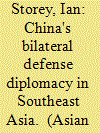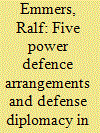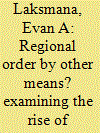|
|
|
Sort Order |
|
|
|
Items / Page
|
|
|
|
|
|
|
| Srl | Item |
| 1 |
ID:
116370


|
|
|
|
|
| Publication |
2012.
|
| Summary/Abstract |
Consonant with global trends, China's defense diplomacy has broadened in the pursuit of new foreign policy and security goals. While realpolitik still informs China's military relations with Southeast Asian countries, Beijing has also utilized defense diplomacy to build cooperative relations, underscore its "peaceful development" thesis, increase transparency, and assuage regional anxieties concerning its rising power. Over the past decade, China has stepped up arms sales to the region, military exchanges and naval ship visits, initiated annual defense and security dialogues, and combined training and exercises. However, China's defense diplomacy in Southeast Asia still faces barriers, including tensions generated by sovereignty disputes in the South China Sea, the poor reputation of Chinese weapon systems, and second-order impacts on Southeast Asian countries' existing defense relationships.
|
|
|
|
|
|
|
|
|
|
|
|
|
|
|
|
| 2 |
ID:
116369


|
|
|
|
|
| Publication |
2012.
|
| Summary/Abstract |
The Five Power Defence Arrangements (FPDA) marked its 40th year of existence on November 1, 2011. What explains the durability of a collection of bilateral consultative arrangements initially conceived in the context of the British military withdrawal from East of Suez? Examining the FPDA as an institutional expression of defense diplomacy in Southeast Asia sheds light on its longevity. The arrangements have successfully operated as a defense diplomacy instrument by fulfilling three core functions. The FPDA has traditionally acted as a psychological deterrent with the fear of an assertive Indonesia in mind. It has performed a confidence-building role in the Singapore-Malaysian relationship. Finally, it has provided Australia, New Zealand, and the United Kingdom with an instrument to be engaged in Southeast Asian security.
|
|
|
|
|
|
|
|
|
|
|
|
|
|
|
|
| 3 |
ID:
116366


|
|
|
|
|
| Publication |
2012.
|
| Summary/Abstract |
Defense diplomacy is a relatively new phenomenon aimed at addressing the strategic complexity and uncertainty of the post-Cold War world. It has hitherto received little analytical attention where defense relations in Southeast Asia are concerned. Our article seeks to redress that lack. Borrowing from historical and contemporary debates on diplomacy, we offer a working definition of defense diplomacy that distinguishes its pragmatic and transformative aspects. Building on the four articles that follow, we suggest that bilateral and multilateral engagements in defense diplomacy by Asian countries have primarily been pragmatic in form and function, aimed at maintaining peaceful and stable regional relations. Our modest contribution is hopefully a useful start to what could in time become a meaningful debate and cumulative knowledge on defense diplomacy.
|
|
|
|
|
|
|
|
|
|
|
|
|
|
|
|
| 4 |
ID:
116368


|
|
|
|
|
| Publication |
2012.
|
| Summary/Abstract |
This article seeks to address why and how defense diplomacy in Southeast Asia has risen in the past decade. By examining multilateral defense diplomacy under the auspices of the Association of Southeast Asian Nations (ASEAN) and the ASEAN Regional Forum (ARF), as well as Indonesia's bilateral defense diplomacy, this article makes three arguments. First, bilateral and multilateral defense diplomacy in Southeast Asia complement one another. Second, the focus of multilateral defense diplomacy has evolved and now reflects the blurring distinction between nontraditional and traditional security issues. Third, the rise of ARF's multilateral defense diplomacy can be attributed to the concern over China's rise, while ASEAN, considers it as among the key mechanisms to recover from the fallout of the 1996 Asian financial crisis and the recent regional arms development.
|
|
|
|
|
|
|
|
|
|
|
|
|
|
|
|
| 5 |
ID:
116367


|
|
|
|
|
| Publication |
2012.
|
| Summary/Abstract |
This article looks at the regionalization of defense relations in Southeast Asia from the Cold War to the present. The evolution of defense cooperation involving the Association of Southeast Asian Nations (ASEAN) countries and their dialogue-partner countries has been impressive, with the formation of the ASEAN Defense Ministers Meeting (ADMM) and ADMM+?defense-ministerial arrangements, themselves the beneficiaries of more established dialogue processes. Despite these developments, the aim of defense regionalism in Southeast Asia has remained decidedly modest. While "action-oriented" cooperation in various nonconventional security areas has been incorporated into its agenda, Southeast Asian defense regionalism persists largely as an exercise in informal confidence building, with at best limited and incidental forays into preventive diplomacy. In conclusion, it still lacks the strategic imperative and institutional coherence befitting a model of regionalism.
|
|
|
|
|
|
|
|
|
|
|
|
|
|
|
|
|
|
|
|
|